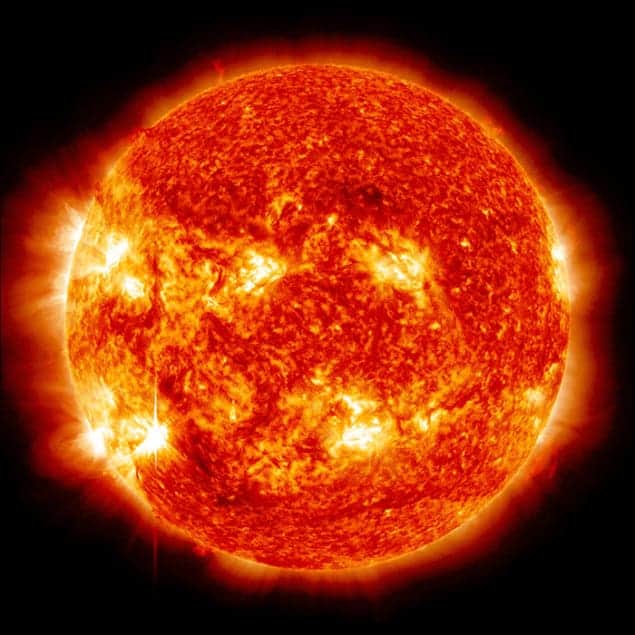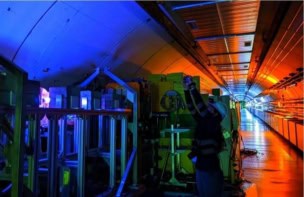
Further evidence that solar neutrinos affect radioactive decay rates on Earth has been put forth by a trio of physicists in the US. While previous research looked at annual fluctuations in decay rates, the new study presents evidence of oscillations that occur with frequencies around 11 and 12.5 cycles per year. The latter oscillation appears to match patterns in neutrino-detection data from the Super-Kamiokande observatory, in Japan. Other physicists, however, are not convinced by the claim.
The idea of fluctuating beta-decay rates is very controversial because for more than 80 years, radioactive substances have been thought to follow a fixed exponential decay, under all conditions. The theory of invariable decay constants was set by Ernest Rutherford, James Chadwick and Charles Ellis in Radiations from Radioactive Substances, published in 1930.
In recent years, however, there have been suggestions that decay rates are not constant and are influenced by the Sun. In 2009, physicists from Purdue University in Indiana published a paper discussing unexplained annual fluctuations in long-term measurements of decay rates of silicon-32 and chlorine-36 at Brookhaven National Laboratory (BNL) in New York and radium-226 at the Physikalisch-Technische Bundesanstalt (PTB) in Germany.
Not so constant
The Purdue researchers noted that decay rates at both experiments appeared to be fastest early in the year when Earth is closest to the Sun. They suggested that the annual decay oscillations could be related to yearly variations in the Earth–Sun distance, with solar neutrinos somehow affecting decay rates.
This idea, however, was met with some scepticism in the physics community. Part of the criticism was that environmental factors, such as ambient temperature, are known to affect decay-rate measurements and might explain the seasonal variations. While others pointed to the fact that neutrinos interact with other particles infrequently and there is no known mechanism that could explain the proposed influence on decay rates.
In the latest research, Peter Sturrock, an applied physicist at Stanford University, Ephraim Fischbach at Purdue and Jeffrey Scargle, an astrophysicist at NASA’s Ames Research Center, performed power-spectrum and spectrogram analysis of the BNL silicon-32 and chlorine-36 data. The study revealed oscillations at frequencies of 11 and 12.5 cycles per year, as well as the previously reported annual oscillation. They also analysed five years of measurements from the Super-Kamiokande observatory and found similar oscillations in solar-neutrino flux.
Similar oscillations
In the Super-Kamiokande data, which were collected between 1996 and 2001, they found oscillations at 12.5 and 9.5 cycles per year. The researchers say that the oscillation at 12.5 could be related to the rotation of the Sun’s radiative zone, while the oscillation at 9.5 may be related to the rotation of the solar core.
The oscillations in decay rates and neutrino flux that occur at 12.5 cycles per year fit with each other. However, the oscillations at 9.5 (neutrino flux) and 11 (decay rate) cycles per year are more difficult to reconcile. The researchers say that the 11 cycles-per-year oscillation could originate in the region between the Sun’s core and radiative zone.
Sturrock told Physics World that his team is the first “to show similar patterns in both decay data and neutrino data. I see evidence of internal solar rotation in both BNL and Super-Kamiokande data”. He adds: “Comparison of spectrograms formed from BNL data and from Super-Kamiokande data shows a remarkable similarity to each other and to what we know (from helioseismology) about the rotation rate of the solar radiative zone.”
Unknown mechanism
Sturrock says that the mechanism behind the effect of neutrinos on beta-decay rates is unknown. “I speculate that neutrinos interact with the W-boson that is believed to mediate beta decay,” he explains. “But I am hoping that some theoretical physicists will take up this problem.”
Others, however, remain unconvinced. Karsten Kossert, a physicist at PTB, says that his own research, with others, on decay rates has shown that there are “some fluctuations in some instrument readings”. “However, since different instruments and/or measurement techniques show different variations, we can exclude solar neutrinos as a common reason for these variations.” He adds: “In some cases, we have shown a clear correlation between environmental parameters – such as temperature, humidity, air pressure – and instrument readings.”
Kossert recently co-authored a study looking at data on decay rates from 14 laboratories around the world. The report concluded that “observed seasonal modulations can be ascribed to instrumental instability” and that “there are also no apparent modulations over periods of weeks or months”.
Not persuaded
The evidence that neutrinos affect beta-decay rates “is not persuasive”, according to Hamish Robertson, director of the Center for Experimental Nuclear Physics and Astrophysics at the University of Washington, in Seattle. He says: “Evidence that fits the hypothesis has been brought forward, while other evidence that does not fit (for example, long-term studies of the beta decay of tritium), is ignored.” He adds: “Fitting the fluctuations to one natural phenomenon after another will eventually lead you to reach a spectacular conclusion.”
Patrick Huber, of Virginia Tech in the US, echoes this, saying that “correlation is not causation”. “Even if we assume there is this variation [in decay rates], I do not find anything in the data indicating that neutrinos have anything to do with it.”
Huber adds that if the oscillations are real and “not due to some experimental artefact”, this requires “extraordinary new physics, and hence it will require extraordinary proof – which the present work is not”. “In particular, it makes no suggestion how to test the hypotheses put forward or where to go next to study this question.”
The study is described in Solar Physics.



